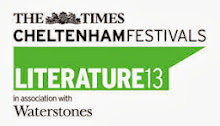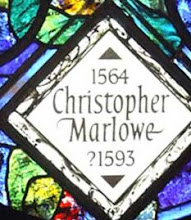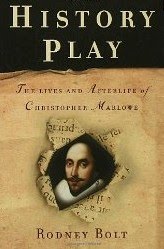According to an item in the Guardian newspaper of 11 July 1983, Calvin Hoffman had been left some notes about it in the will of a journalist friend of his. Here is what it says:
"CALVIN HOFFMAN, probably the most indefatigable friend the Elizabethan playright (sic) Christopher Marlowe ever had, will travel to Italy next week in what he hopes will be the conclusive phase of his 30-year campaign to prove that Marlowe wrote the works of Shakespeare.
This is to follow up written evidence indicating that documents could exist showing that Marlowe lived in hiding in Padua, creating the entire Shakespearean cannon (sic), for 34 years after his supposed death in a tavern brawl in 1593. The evidence is in the form of notes which Mr Hoffman, aged 75, an American former theatre critic, received this year from the will of a journalist friend. These say that a 16th century Paduan, Petro (sic) Basconi, left papers stating that an English writer named Marlowe lived with him as a recluse until dying in 1627, 11 years after Shakespere's (sic) death. The notes add that the writer had "had to leave England." The papers were passed down the Basoni (sic) family and were said to have been shown during the 19th century to a British ambassador to Italy, who is said to have commented that he was "afraid to tamper with a matter so dear to the English heart." ... "Mr Hoffman does not know where to begin looking in Padua."
He did in fact go there and succeeded in finding a 17th century grave for someone called Merlin, a name used for Marlowe when he was at Cambridge, only to discover that it is quite a common name in Padua. He found nothing else.1
It is too good a story to just be left alone, however, and other Marlovians have tried to see what truth there might be in it.
In his 2001 film Much Ado About Something, after hearing of the Guardian account from John Hunt, Michael Rubbo also discovered the existence of a 1983 letter from Hoffman on the same subject, and showed that it mentioned Washington Irving (US Ambassador to Spain, 1842-6, who had apparently seen the relevant document) and Whitelaw Reid (US Ambassador to the UK, 1905-1912). Mike discussed the story with the archivist at Mantua, Dr. Ferrari, but—not really surprising as Padua is over 50 miles from there—found nothing.
In April 2003, Christian Lanciai reported to an internet newsgroup that he had visited three different archives in Padua, finding only (in the Archivio della Stato) that nobody with a name like Marlowe appears in a record of all the deaths in Padua from 1626 to 1651. He did find a Merlini who had died there in 1647, but "no confirmation at all in the city archives of Padua...that Christopher Marlowe had died there in the 1620s." His piece was also published in the Marlowe Society's Newsletter 22, of Spring 2004.
Izabel Gortázar mentioned the result of her research on this in an essay for the Marlowe-Shakespeare Connection blog on 20 September 20102 when she said that she "found no Basconi or Bosconi families in the Padua records." Amplifying this for some of us she said "A few years ago I went to Padua in search of Marlowe. Luckily I had friends who ensured that I had entry to the old Municipal, Church and University records and that I could talk to Librarians and Professors. Although I only spent a few days there I could not find any records of a Basconi/Bosconi family, and indeed was dissuaded by the Librarians to continue looking for such name, assuring me that there had never been a Bosconi or Basconi family in Padua."
Some Marlovians, amongst whom I count myself, nevertheless thought that there might even yet be something in it. At least we did until Edward Clybourn told us about a newspaper article he had found, dated 23 April 1916, which he correctly thought must cast doubt upon the truth of the whole thing. It was from the Pittsburgh Post-Gazette and was by Henry Watterson, a Pulitzer Prize-winning journalist who was editor of the Louisville Courier-Journal for more than 50 years (1868-1919).3
The first half of it consists mainly of a summary of, and apparent agreement with, his friend Mark Twain's argument against Shakespeare's authorship of the works attributed to him. "Thus Mark Twain briefs the case. Not a single statement can be gainsaid. The conclusion is dead against Shakespeare." Next he considers the Baconian case, finding some merit in it, but also disliking some aspects. He mentions how in a discussion with Whitelaw Reid, American Ambassador to the UK, Reid wouldn't check whether one Baconian argument was true or not, saying that he would not even if he could, "meaning of course that as American Ambassador he could not afford to meddle in such a controversy." Before and after the Bacon bit, however, are anecdotes apparently about how people feel free to make anything up in support of a story if they have enough belief in their version of it. Whereupon he illustrates this with his own story, written of course before Leslie Hotson's discovery of the inquest, and containing a whole lot of information which we now know to be completely wrong.
"TO COME directly to the point, there is a simple but perfect thesis in explanation of the Shakespearean mystery," he said. "This relates that the plays were written by Christopher Marlowe. They were revised by Francis Bacon. Thus prepared for the stage, they were produced by William Shakespeare." Then comes the "story". Marlowe and Shakespeare were celebrating in a tavern when he got into row with an actor called Herrick, who was accidentally killed in a scuffle. Marlowe's friend and "former classmate" Francis Bacon happened to be passing and helped to sort it out. Marlowe and the dead Herrick would swap clothes and the former "fly for his life". "Next day it was given out that Marlowe had been killed, and, the penalty death for him in case he came to life again, it was ever after thus proclaimed." He travelled to Paris and Spain, and "Finally, all individual traces lost, he repaired to Italy and settled down in Padua." There he wrote the plays which he sent back home to Bacon.
So far, so good, but now Watterson gives full rein to his imagination:
"Bacon left no cryptogram. No more did Marlowe. But, in an early edition of the Lemounier (sic) Vasari, the Comte de la Borde (sic), correcting one of the many errors in the Guida de Bassano,4 refers to a recluse of Padua, Pietro Basconi by name, who claimed to have nursed Marlowe in his last illness (Marlowe died in 1627, just a year after Bacon's death), and to have had from him the story and reduced it to writing. This strange composition came into the possession of Andreas Basconi, a descendant of Pietro, and was read, we are told, as late as 1843 by no less a person than Washington Irving, who, thinking it a doubtful yarn, and with Whitelaw Reid, knowing it dangerous for a man of importance (he was the American minster (sic) to Spain) to tamper with a subject so sacred to the British heart, wrote nothing about it, nor, indeed, spoke of it except to one or two intimate friends."
So could it have happened like that? "Why Not? Why Not?" Watterson asks. Couldn't a friend of his, long resident of Florence, have heard the story and told him about it? Or why, when in London, couldn't he have "fallen in with a ragged Italian in Leicester Square who, born and reared in Padua, had an inkling of the truth and who tried to sell me a plaster cast of Christopher Marlowe, declaring that, if I would go with him on a dark night into a wood by the river Wye, he would produce from the hollow of an old oak the identical Basconi manuscript."
Now comes the important bit. "Go to! Go to!" he says. "I am not on the witness stand making oath to anything—only pursuing the usual Bacon-Shakespeare method" ... "Why may I not call from the shadows and the stars the strange story of Christopher Marlowe ... at the moment of his supposed death the greatest of English poets and dramatists...many of whose early conceits, and some of his actual phrasing, to be found in the plays later ascribed to William Shakespeare?"5 In other words, whilst agreeing with the Marlovian theory, the story he told about it was "from the shadows and the stars"—all made up. In fact it is easy to see that the bit about the River Wye must have been inspired by the actions in 1907 of a Baconian, Dr. Orville Ward Owen, who claimed he had decoded instructions revealing that a box containing proof of Bacon's authorship had been buried in the River Wye near Chepstow, but whose dredging machinery failed to retrieve any concealed manuscripts.
Henry Watterson did clearly favour the Marlovian theory over any other. The Wikipedia article6 on the Louisville Courier-Journal says that "He attracted controversy for attempting to prove that Christopher Marlowe had actually written the works of Shakespeare" and the New York Times carried his reaction to the Oxfordian book of J. Thomas Looney, saying that "My own guess—we can only guess—has always been that Marlowe wrote the plays."7 His correspondence with Wilbur G. Zeigler—the first known Marlovian—is also held in the Library of Congress, and should be well worth reading.8
The date when his article appeared is an interesting one, though. Not only was it the exact tercentenary of Shakespeare's death,9 but it followed hard upon a quite extraordinary court case, which ran from 3 to 21 April, in which a Colonel Selig—who had produced several films about Shakespeare (presumably ready for the tercentenary)—sued a Baconian, Colonel Fabyan, because the recent publishing of his anti-Stratfordian theory would lose Selig money. The judge actually came down on Fabyan's side because he found that Bacon must indeed have written the works of Shakespeare! The plaintiff and defendant were apparently good friends, however, and cynics suggested that the publicity given to Selig's films would have been well worth the cost to him of those proceedings. Watterson's article appeared on 23 April as a signed front-page feature article in his own Courier-Journal, which apparently realized over a thousand dollars for its syndication of the story to other newspapers.10
So how is it that Calvin Hoffman got hold of this, and thought it worth following up? We know that the notes about it had been left to him in 1983 by a friend of his. Any of Henry Watterson's five children would have been well over 100 years old by then, so we are probably looking at one of his grand—or great-grand—children. It is in fact interesting that the Watterson Papers as held at the University of Louisville carry on until 1983, despite his having died in 1921. Perhaps this descendant lived until 1983, having carried on collecting related documents, and then left them all to the University of Louisville and the Library of Congress, except for one item. They left the "notes" about the Basconi/Padua story to Calvin Hoffman, because they not only knew of Henry's beliefs but also that Hoffman's 1955 book had argued much the same theory. It is just a pity that they seem to have missed their ancestor's point—that that bit was just a story.
©Peter Farey, 2012
1 I am grateful to Gene Ayres for sharing with me this information which he obtained from the then archivist at King's College Canterbury, Paul Pollak.
2
3 The article is quite long, but it can be found online at http://tinyurl.com/watterson-item
4 The earliest edition of Vasari’s writings published by Lemonnier appeared in 1846. As Ellen Wilson pointed out to me, this must therefore refer to Léon-Emmanuel-Simon-Joseph, Comte de Laborde (1807-69). He wasn't one of Lemonnier’s editors, however, so this would appear to have been in the form of handwritten marginalia.
5 I have corrected part of this, where the lines were set in the wrong order.
6
7 Thanks to Ellen Wilson for finding this at http://tinyurl.com/watterson-NYT
8
9 Thanks to Anthony Kellett for pointing this out.
10 Wall, Joseph Frazier. Henry Watterson, Reconstructed Rebel (1956). Oxford University Press, New York. pp.293-4.

















